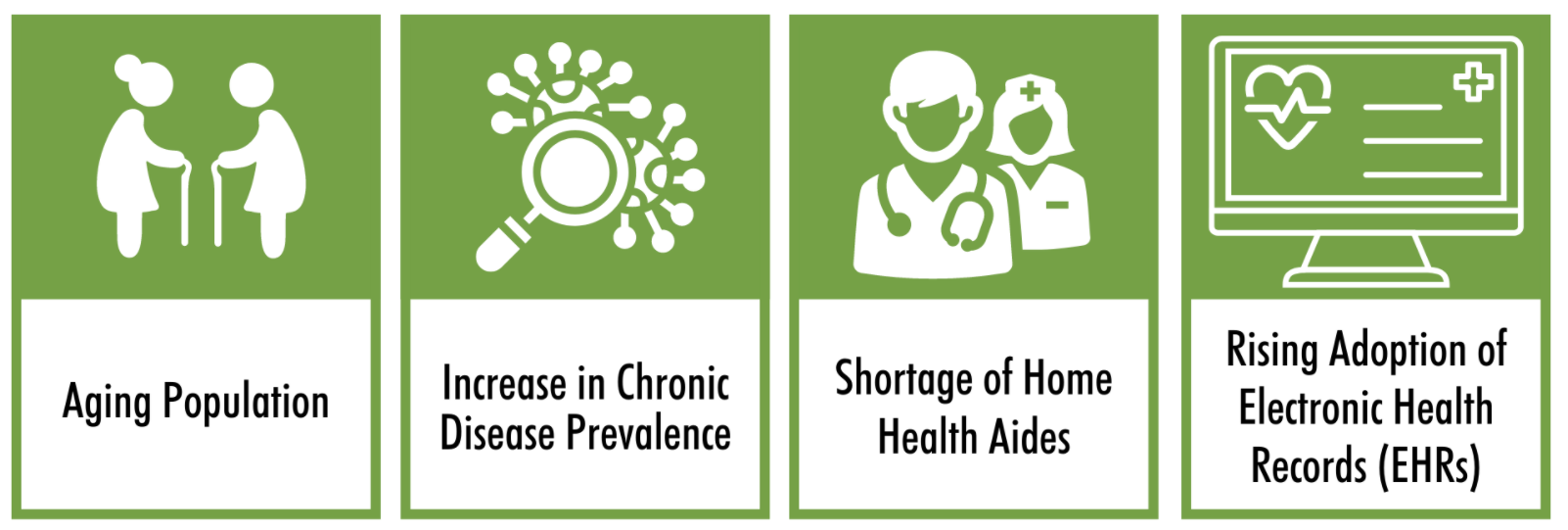Written by: Shachi Merchant
Healthcare is one of the few sectors of the economy that has struggled to keep pace with today’s technologies. Prior to the pandemic, we had hit an inflection point where modernization was no longer a choice, but a requirement. Now the need to digitize and innovate within the industry has become dire. First, we must understand the current landscape driving this demand—then we can follow the investments and companies paving the path to better patient care through prevention and increased access.
Understanding the current healthcare landscape and the need for innovation
Healthcare costs, both on a global and national level, are rising at unsustainable levels. This is due to a confluence of factors, including the growing aging population, increase in chronic disease, shortage of physicians and nurses, lack of access to care, and increase in digital demand by hospitals and patients.

- The aging population is expected to double in the next 20 years.
- The prevalence of chronic disease is increasing, accounting for 81 percent of U.S. hospital admissions, 91 percent of all prescriptions filled, and 76 percent of all physician visits.
- A study conducted by consulting firm Mercer showed that the U.S. will face a shortage of 400,000 home health aides and 29,400 nurse practitioners by 2025.
- Electronic medical record and electronic health record adoption is rising -- 93 percent of American hospitals now use EHRs, which represents a rise of 20 percent in the last ten years. Legislation slated to take effect in 2022 is evolving to meet increased digital demand, allowing patients to download their EHRs onto digital devices.
In addition to all these factors, the COVID-19 pandemic shattered previously established barriers to innovation and catalyzed digital health. Innovation in healthcare is creating new avenues through which to treat patients remotely, improve patient flow through digital appointments, and reduce emergency care services through predictive modeling, artificial intelligence, and technology.
A shift from sick care to preventative care
A spotlight is on preventative medicine in an effort to combat chronic illness management, improve health outcomes, and reduce rising costs. As annual checkups and urgent care visits were rescheduled and reshuffled by the pandemic, several companies emerged with innovative approaches to tackling the ongoing healthcare crisis. Two interesting examples of these technology trends can be seen through the use of telemedicine and genetic testing in the primary care setting.
Telemedicine
The rise of the “virtual doctor” allows patients to access physicians and clinicians via videoconferencing apps, usually on their smartphones and tablets, but also via traditional PCs. Telemedicine is incredibly instrumental for those patients who are unable to easily leave the home for a traditional provider visit and for those who live in remote or rural areas.
The HTEC index has a 1.41 percent weight in Teledoc Health, Inc. (TDOC), one company that is at the forefront of the telemedicine industry. TDOC expanded its remote health offerings in 2020 by merging with Livongo, a digital health company and former HTEC member that builds out remote healthcare solutions for patients suffering from diabetes and hypertension.
Genetic testing
Genetic testing is an important medical tool used to assess various inheritable diseases, conditions, and cancers earlier than ever before possible. Early diagnosis, sometimes even before symptoms surface, helps to lessen the severity of symptoms in the long term and promote a better quality of life for patients.
The HTEC index holds a 1.30 percent weight in Fulgent Genetics, Inc. (FLGT). Fulgent, together with its subsidiaries, provides COVID-19 testing and genetic testing services to physicians with clinically actionable diagnostic information. Its technology platform integrates data comparison and suppression algorithms, adaptive learning software, and genetic diagnostics tools and integrated laboratory processes. The company primarily serves insurance companies, hospitals, and medical institutions. Fulgent Genetics collaborates with PWNHealth to provide at-home COVID-19 test capabilities and has a strategic partnership with Helio Health, Inc. to commercialize blood-based early cancer detection tests.
Projected investment trends across healthcare technology
Judging from supporting legislation, the increased need, and the current shortage of healthcare professionals, healthcare innovation is here to stay. This evolving industry is creating an influx of investment opportunities. The ROBO Global Healthcare Technology and Innovation Index (ticker: HTEC) provides investors with exposure to global health tech companies that are harnessing powerful technologies to create products and services that benefit both patients and providers.
Here are two of the major deals and funding details that prove that we’re in the midst of a healthcare revolution:
- This year, there have already been 73 deals (completed and pending) worth $50.1B made by HTEC members as of August 30, 2021.
- This year is on track to overtake 2020’s 93 deals (completed and pending) valued at $66.7B.
If you follow the money, all signs point to growth and continued development in the world of healthcare technology. HTEC is a dynamic, global portfolio of companies working to change the future of healthcare. Investing in innovation will impact us for generations—healthcare’s moment is now.


